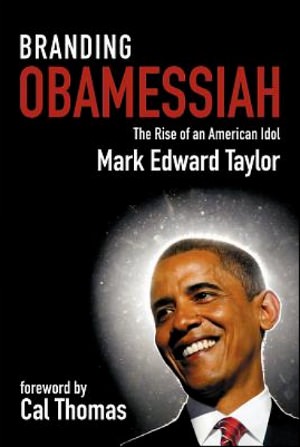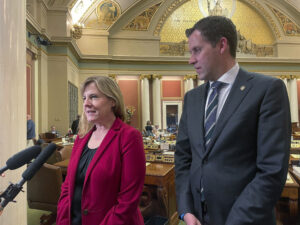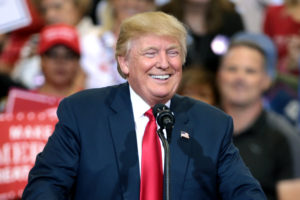Slouching Toward Washington
Mark Edward Taylor's "Branding Obamessiah: The Rise of an American Idol" lays out the six sacred branding strategies -- taken from the world of advertising -- used to turn a mere mortal from Chicago into the image of an American savior.Mark Edward Taylor's new book lays out the six sacred branding strategies used to turn a mere mortal from Chicago into the image of an American savior.
“Branding Obamessiah: The Rise of an American Idol” A book by Mark Edward Taylor
Mark Edward Taylor, in “Branding Obamessiah: The Rise of an American Idol,” carefully reconstructs how six sacred branding strategies turned a mere mortal into an American savior. Taylor clearly believes that Barack Obama was too politically inexperienced to become president of the United States. Our current president was, however, very skilled at branding. Obama’s strategies were composing a creation story, chanting sacred words, venerating sacred images, observing sacred rituals, bringing in believers and coloring the messiah.
Although the sacred six are an unoriginal appropriation from the world of advertising, Taylor neatly grafts them onto the 2008 presidential campaign by beginning with Obama’s creation story of racial angst during his childhood in Hawaii. Taylor goes to great pains to argue that Obama’s memories within “Dreams from My Father: A Story of Race and Inheritance” were manipulated to create a racial consciousness that Obama most likely did not experience and furthermore did not even write. He critiques the text for having “so little real evidence of abject, institutional racism,” and suggests that “Obama understood the power of race to open doors, and so he created a story that would make his skin’s color more vivid.”
As evenhanded as Taylor is throughout the book, his dismissal of Obama is rarely as stark as when he claims being a black boy in Hawaii couldn’t have been that bad. Irrespective of who crafted Obama’s memoir and why, Taylor is wrong to dismiss Obama’s account of racial trauma. An outsider has no right to estimate the psychological impact of racism, especially if the outsider has never lived as a person of color.
In the same way that race is a key word in “Dreams from My Father,” hope and change were the sacred words of Obama’s campaign. Whether used individually or combined as hope for change, Obama’s words addressed Americans’ desperate need for anything other than the George W. Bush legacy. So desperate were his constituents that no one ever queried the actual meaning of the terms. Taylor points out that ” ‘change’ doesn’t indicate direction, ‘hope’ isn’t a strategy and ‘believe’ doesn’t refer to an object beyond itself.” Taylor historicizes the consistency of “change” as a presidential campaign motif, but explains how Obama embodied change as a young, handsome, part-black political novice who starkly contrasted his opponents’ stagnant “experience.” He continues:
A troubled and anxious people are susceptible to promises of an easy fix. Obama was careful to utter just enough for many Americans to hear what they wanted to hear in his sacred words — words that motivated but did not explain. Words that moved voters to act but not to reflect. Words that triggered emotion but not critical understanding. People translated Obama’s words into their own image and in turn projected that image onto him. And by creating images of a utopian future that went far beyond dull, policy-driven reality, they unwittingly became a band of prophets proclaiming the coming of a messiah who was promising everything — and promising nothing.
Similarly, the sacred images of the campaign asked audiences to project positive messages onto Obama’s visual representations. Not only was Obama depicted with halos of light above his head, but visual incorporations of Obama imagery with figures such as Abraham Lincoln and Martin Luther King Jr. “made him into an historical figure before he even had a chance to make history,” according to Ron English, an artist quoted by Taylor. Lest he get too wrapped up in history, Taylor explores Obama’s rock star appeal by analyzing his appearances in Rolling Stone, Vibe and other popular magazines. Because an unflattering picture of the presidential candidate never emerged, each handsome, virile image made Obama increasingly attractive to voters. Additionally, Taylor describes how “Team Obama” masterminded “logobama” — a logo that would appeal to everyone at once. The open O of the campaign logo allowed various communities to accommodate their individual priorities into Obama’s message.
Throughout the book, Taylor assures readers that nothing was left to chance during the Obama campaign. And although he never says that the 10 rallies where women attendees passed out and were sympathetically acknowledged by Obama were staged, one wonders about the regularity of the ritual and begins to view Team Obama with an aura of suspicion. Taylor describes Team Obama’s uncanny knack for maximizing social media, and how some sectors of the ailing economy profited from Obama paraphernalia and tours of his Hyde Park, Chicago haunts.
Not only did Obama believers swoon and faint at rallies, follow him on Facebook and buy merchandise, but his devotees voted for him because the campaign focused on his parasocial relationships with the public. People who didn’t know Obama became convinced that they could have a beer with him, play a game of pickup basketball or have dinner with his beautiful family. People simply loved him. His Hollywood appeal even persuaded celebrities to contribute to the “Barockstar” idolization.
Taylor concludes where he began, discussing the role of race in Obama’s appeal. He writes, “Obama’s skin was a magnet, pulling black voters together in one near-monolithic block, unmovable and resounding with his praises.” All the while absolving white voters of their guilt. Blacks and whites could vote for their first black president and be proud of how far their country had come. And so they did. “Branding Obamamessiah” was published near the beginning of the 2012 primaries, and it curiously ends with Obama’s 2008 election. Certainly, the strength of the book is its compendium of sources, but should it have taken four years to publish them? Where is the projection to the future? The book feels unfinished. It also appears to lack the salient marketing feature of relevance. Or so I thought before I went to the website. Brandingobamessiah.com includes everything the book lacks. From Twitter feeds and a Facebook friending opportunity to author biographical sketches, images, videos and recent blog posts about the 2012 campaign, Taylor reminds readers that branding was for products long before it was for presidents.
It is the 21st century, after all. Most Americans connected via social media acquiesce to some level of personal branding or identity management as an integral part of our lives. When we want to acquire friends, employment, fame or profits from selling our own products, our mediated representations of ourselves do not always reflect who we are in other areas of our lives. A man or woman running for the most venerated public office in the United States of America should most certainly not leave any aspect of his or her image to chance. But, as the final sentence of the epilogue asks, “Would Obamessiah be resurrected for the next election?” It is too soon to tell, but it doesn’t look good.
Taylor makes a rather convincing argument that Obama’s success was built on his being a neophyte. He had no national familiarity before his 2004 Democratic National Convention appearance. Quite strategically, he had no voting record to speak of as a senator because he voted “present” more than “yea” or “nay.” On the campaign trail, he had no previous political persona to overcome. And he made no clear promises. Today, Obama’s tabula rasa days are over. As president he has an indisputable record of decision making that has left many former believers feeling duped. It seems impossible that Obamessiah could be resurrected.
People frustrated with the decimation of state budgets, high unemployment, extremely high gas prices and the faint but constant beating of the drums of war — with Iran and against women’s bodies — may feel the messiah failed to deliver on his promises. It is essential, however, to remember two things. 1) Not everyone, including the black voters who Taylor alludes to as a monolithic block, believed Obama was a savior. And 2) Obama made no promises. Taylor observes, “Obama’s greatest political asset was his affable ambiguity. Devotees projected their own personal vision onto the candidate and required that he offer nothing back in detail to see if their notions matched his reality.” The machinations behind Team Obama and the 2008 campaign say more about the American people than they say about the president. Remember “Yes we can”? Frustrated citizenry must acknowledge responsibility as the “we” in making a man into a messiah.
2012 presents the nation with another opportunity to “change.” Let’s hope that this time voters will be less enamored by a personality and be savvier participants in the implications of policy. Instead of waiting for a messiah, what if U.S. citizens saved themselves? Protests that led to the reversal of the Susan G. Komen Foundation’s decision to divest from Planned Parenthood and Occupy movements are excellent examples of the potential for people to work with public leaders instead of waiting on their leaders to work for them. This is the lesson of “Branding Obamessiah.” It is easy to be disappointed when we buy into a leader. Perhaps in the future, we will invest more in ourselves. Yes, we can.
Your support matters…Independent journalism is under threat and overshadowed by heavily funded mainstream media.
You can help level the playing field. Become a member.
Your tax-deductible contribution keeps us digging beneath the headlines to give you thought-provoking, investigative reporting and analysis that unearths what's really happening- without compromise.
Give today to support our courageous, independent journalists.







You need to be a supporter to comment.
There are currently no responses to this article.
Be the first to respond.